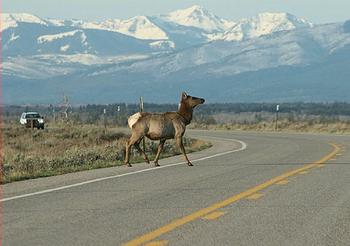
WASHINGTON, DC, July 29, 2013 (ENS) – Wild animals in national parks are dying by the hundreds under the wheels of visitors’ cars, according to road-kill records from Yellowstone, Yosemite and Grand Teton national parks released today by Public Employees for Environmental Responsibility, PEER.
The National Park Service has no policies or guidance addressing road-kill, so individual parks are left on their own.

As wildlife-vehicle collisions continue to climb in national parks, Yellowstone takes no preventative measures, while Grand Teton invests financial resources to analyze and reduce these usually fatal interactions.
Documents obtained by PEER under the Freedom of Information Act show that in Yellowstone National Park, the average number of grizzly bear deaths from vehicle collisions has doubled in the decade since 2000, while collisions involving bison and black bears have risen nearly 50 percent during the same period. Since the introduction of wolves to Yellowstone, road-kill of elk, deer and other ungulates has fallen along with their populations, but wolves now figure in collisions with five wolves killed in 2011 alone.
Yosemite National Park has had 300 collisions with black bears since 1995 but does not systematically collect data on other species, the park reports.
Wildlife are increasingly common casualties of motor vehicle collisions in Grand Teton National Park. Grand Teton tracks vehicle impacts for 24 different species and analyzes the circumstances surrounding accidents – time of day, traffic volume and speed, as well as the car’s license plate. Park analysts discovered that roughly a quarter of the drivers were local residents, who often were commuting rather than sightseeing.
“Road-kill in national parks is a growing conservation failure,” said PEER Executive Director Jeff Ruch, pointing out that the causes of road-kill, other than cars themselves, are varied and complex.
“In some cases, vegetation in the median strip functions like a salad bar drawing animals into harm’s way. Once hit, the resulting carcass attracts scavengers who, in turn, get hit by passing cars,” said Ruch.
While there are similar patterns among these three national parks, their response to vehicular wildlife mortality could not be more different.

Records show that Grand Teton has proactively implemented and tested an array of mitigation measures, including reducing speed limits at night, when most collisions occur, and variable message signs.
“There was a distinct mid-summer peak in WVCs [wildlife-vehicle collisions] that coincided with a peak in visitation, suggesting the number of WVCs is a function of traffic density,” the Grand Teton analysis states.
“The majority of collisions, 91, occurred during the snow free months (May-October). Patterns of WVCs varied by species. Collisions with elk peaked in June while pronghorn peaked in July, and those involving deer peaked in August,” according to Grand Teton records.
Yosemite launched a visitor education campaign called “Red Bear, Dead Bear” in 2005, which places red signs along roadways where bears have recently been hit. The park has not studied the program’s effectiveness, although bear deaths continued to rise after 2005, as have the number of red bear signs stolen.
Yellowstone has taken no steps to minimize road kill. The park has made road improvements which have led to higher vehicle speeds, such as widening roads and increasing the number of pull-outs for slower traffic. The park had no record of any study or planning on the issue, aside from reviews required under the Endangered Species Act.
“Yellowstone views road-kill as inevitable as the sunrise, while Grand Teton regards it as a behavioral issue which can be managed,” Ruch said.
PEER is developing a best practices guide for park superintendents and wildlife refuge managers, detailing the techniques which have successfully reduced road-kill.
Ruch said, “The problem of road-kill merits greater park management attention because, besides the needless wildlife carnage, these collisions endanger the people involved and account for a lot of property damage.”
Copyright Environment News Service (ENS) 2013. All rights reserved.
